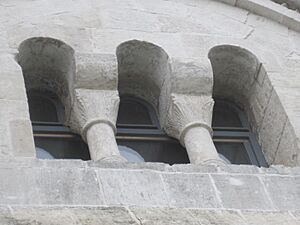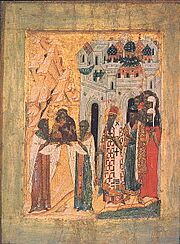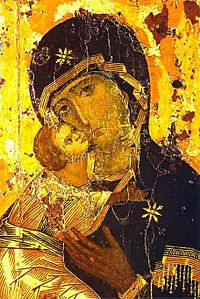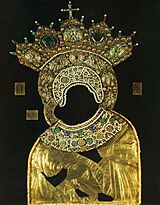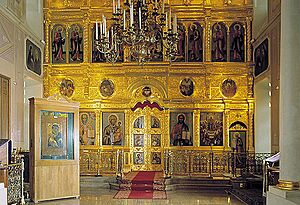Virgin of Vladimir facts for kids
Quick facts for kids Virgin of Vladimir |
|
|---|---|
| Russian: Владимирская икона Божией Матери: Our Lady of Vladimir | |
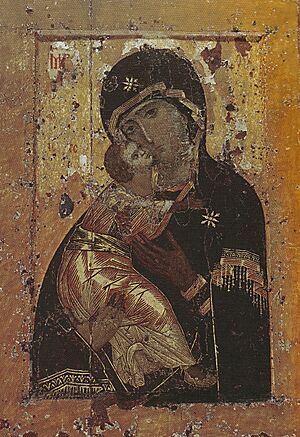 |
|
| Artist | Unknown |
| Year | 1131 |
| Medium | Tempera |
| Subject | Virgin Mary |
| Dimensions | 104 cm × 69 cm (41 in × 27 in) |
| Location | Tretyakov Gallery, Moscow |
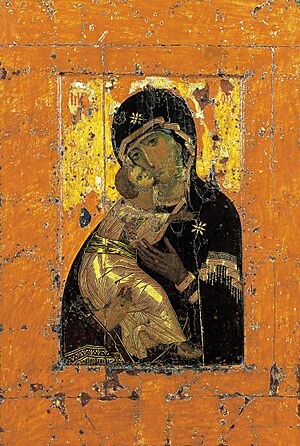
The Virgin of Vladimir, also called Our Lady of Vladimir, is a very old and important painting. It is a Byzantine icon from the 12th century. The painting shows the Virgin Mary and her son, Jesus Christ, as a child. It is a special type of icon called Eleusa, which means "tenderness" or "compassion".
This icon is one of the most famous and important artworks in Russian history. Many people believe it has protected Russia and that miracles have happened because of it. The icon has been repaired at least five times because it was damaged over the centuries.
An unknown artist likely painted the icon in Constantinople. It was sent to Kiev as a gift around 1131. Later, it was moved to the Assumption Cathedral in Vladimir. People traditionally say the icon stayed in Vladimir until 1395. Then, it was brought to Moscow to help protect the city from an invasion by Timur.
By the 1500s, the icon was in the Dormition Cathedral in Moscow. It stayed there until the Russian Revolution. After the revolution, it was moved to the State Tretyakov Gallery. Today, the icon is kept at the Church of St. Nicholas in Tolmachi in Moscow. This church is special because it works as both a church and part of the museum.
Contents
Journey of the Icon
How the Icon Began
The Virgin of Vladimir icon was painted in the early 1100s. It arrived in Rus' (an old name for Russia) around 1131. Experts believe it was painted in Constantinople, which was a major city for art at that time. Only the faces of Mary and Jesus are from the original painting. Their clothes were repainted later because they were damaged by a metal cover and a fire.
Around 1131, the Greek Patriarch of Constantinople sent the icon as a gift. It was given to Grand Prince Yuri Dolgorukiy of Kiev. The icon was first kept in a nunnery in Vyshhorod. Later, Yuri's son, Andrey of Bogolyubovo, moved it to Vladimir in 1155.
A traditional story says that the horses carrying the icon stopped near Vladimir and would not go any further. People in Rus' believed this was a sign that the Virgin Mary wanted the icon to stay there. Andrey then built the Assumption Cathedral in Vladimir. The icon was moved to this cathedral after it was finished in 1160.
The icon stayed in Vladimir for a long time. However, it did not stop the city from being attacked and burned by the Mongols in 1238. The icon was damaged in that fire. It was repaired soon after, and again in 1431 and 1512.
Moving to Moscow
A legend grew that Luke the Evangelist himself painted the icon. This story first appeared in writing around 1512. People also believed that the icon helped save Moscow from attacks in 1451 and 1480.
The icon was brought from Vladimir to Moscow in 1395. This happened during an invasion by Timur (also known as Tamerlane). The place where people from Moscow met the Vladimir group is now marked by the Sretensky Monastery. It is said that Vasily I of Moscow cried over the icon all night. The next day, Timur's armies retreated. People in Moscow decided not to return the icon to Vladimir. Instead, they placed it in the Dormition Cathedral inside the Moscow Kremlin.
Some historians believe the icon was still mostly in Vladimir until the 1520s. The stories about the icon saving Moscow in 1395 became popular later, in the late 1400s and 1500s. From the 1500s, the Vladimir icon became a very important symbol. It helped connect Moscow to earlier Russian history and showed Moscow as a major center of Christianity.
After the Revolution
After the Russian Revolution, the icon was taken by the State Tretyakov Gallery. It was shown as a work of art starting in 1930. During the Battle of Moscow in World War II, some say that Joseph Stalin had the icon flown around the city. This was done to protect Moscow from the German invasion.
In 1993, the icon was moved to the Epiphany Cathedral for a special church service. This happened during a time of tension between President Boris Yeltsin and the Russian government. The icon was damaged during this trip. However, it was soon repaired and given to the Church of St. Nicholas in Tolmachi.
What the Icon Looks Like
The icon is a tempera painting on wood. It measures about 106 by 69 centimeters (42 by 27 inches). The central part, about 78 by 55 centimeters (31 by 22 inches), is the original painting. The rest was added later, perhaps to fit a larger metal cover.
The painting shows Jesus Christ as a child in the arms of his mother, Mary. Their cheeks touch, and the child looks towards Mary and reaches for her. Mary holds him with one arm and looks out at the viewer with a serious expression. The faces and hands are painted with dark green and olive colors, with lighter shades on top. The child's face is lighter than Mary's, perhaps to show their different ages. The child's clothes are painted with dark yellow and gold. The original painting had the letters "ΜΡ ΘΥ", which is short for "Mother of God". Only parts of these letters remain.
Over its nine centuries, the icon has been repaired and repainted at least five times. This was done to fix damage and wear. The faces of Mary and Jesus, and the gold background above Mary's head, are mostly from the original 12th-century painting. In the past, the icon was covered with fancy metal covers called oklad or riza. These covers sometimes damaged the wooden frame.
The back of the icon is less known. It has a painting from around the 1300s. This painting shows the Hetoimasia (a "prepared throne") and symbols of Christ's suffering. Before this, the back had a painting of an unknown saint.
The Virgin of Vladimir is an Eleusa icon. This means it shows a very tender connection between the mother and child. Religious thinkers have often talked about the icon's meaning. Theologian Henri Nouwen noted that Mary's eyes seem to look "inward and outward at once." He also said her free hand points to Jesus, inviting us to come closer to him without fear.
Art experts have highly praised the icon's artistic quality. Art historian David Talbot Rice called it "one of the most outstanding religious paintings of the world." Another historian, George Heard Hamilton, admired its "craftsmanship and conception." He noted how the artist made the faces look very real. The icon's expressive and human-like style makes it different from earlier Byzantine art. It shows new artistic ideas from that time.
Why the Icon is Important
Its Role in Russian History
The Virgin of Vladimir is seen as one of the most treasured symbols in Russian history. It is closely linked to Russia's national identity. When it was moved from Kiev to Vladimir, it helped show Vladimir as a new important city in early Russia.
The icon is also considered a "national palladium." This means it is believed to protect the country. One recent example was in 1993. The icon was brought to the Epiphany Cathedral to help bring peace during a difficult time in Russia.
As a Religious Symbol
People also deeply respect Our Lady of Vladimir because the Virgin Mary is seen as the holy protector of Russia. This honored image has been used in important ceremonies. These include the crowning of tsars and the election of church leaders.
The icon has three special feast days each year. These days celebrate specific events linked to the icon:
- June 3: To celebrate Moscow being protected from an attack in 1521.
- July 6: For the victory against an enemy in 1480.
- September 8: To remember Moscow being saved from an invasion by Timur in 1395.
Where to See the Icon
The Virgin of Vladimir is displayed at the Church of St. Nicholas in Tolmachi. This church is special because it is both an active Russian Orthodox church and a museum. This arrangement was made after a disagreement between the Tretyakov Gallery and the Moscow Patriarchate about who owned the icon.
In 1997, the Tretyakov Gallery finished restoring the church. They added special security features to protect the art. An underground passage was also built to connect the church to the State Tretyakov Gallery. To keep the famous icon safe, a special temperature-controlled, bulletproof glass case was made. The icon was placed in this case on September 7, 1996. The next day, the church was officially blessed. The church's leader said the case could even stop bullets from a Kalashnikov rifle.
Because the church is both a church and a museum, visitors can pray before the icon. Church services are also held regularly on certain days. However, visitors can only enter the church through the Tretyakov Gallery and the underground passage.
Copies and Influence
The original Virgin of Vladimir icon has been copied many times over the centuries. Many of these copies are also very important artworks and religious items. The icon became a model for many Russian paintings of the Virgin Mary.
For the 1980 Summer Olympics, a chapel was built for athletes to pray. This chapel had a copy of the icon.
See also
- Our Lady of Vladimir Church – a church in St. Petersburg dedicated to the icon
- List of oldest Russian icons
|


